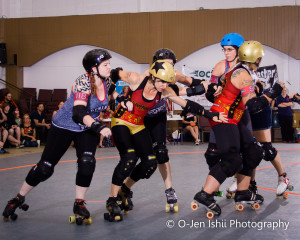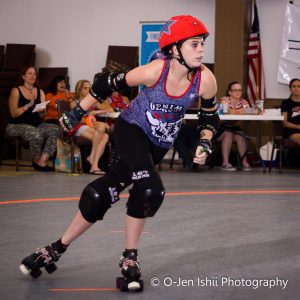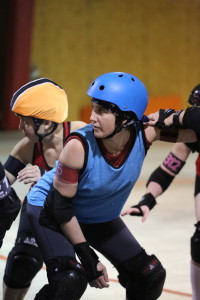
You may have attended her lectures. You may have sat next to her in class. All the while, Hate Ashbury and Hale Damage have been your peers, skaters of The Atlanta Rollergirls.
Hate Ashbury is a Georgia State professor. Hale Damage is a Nursing student. The various women such as these exemplify what creates the unique culture of roller derby.
————
Hate

Photos Submitted | O-Jen IShii
Formally known as Michelle Brattain, Hate Ashbury is the chair of Georgia State’s History Department. Brattain’s specialty is modern U.S. History and regularly teaches U.S. in the 1960’s, 20th Century U.S. and the History of Sex.
“I’m currently co-teaching a 3000-level course on the History of Sex,” Ashbury said.
Brattain discovered the world of roller derby when a former photography professor at Georgia State skated with the Atlanta Rollergirls and invited her to come watch.
“I went to watch her play, fell in love with the sport, and really wanted to try out,” Ashbury said. “I was pretty athletic. At the time I was running marathons, but I was very nervous about derby.”
Ashbury went for it, joined the Atlanta Rollergirls and was pleasantly surprised at how athletically demanding derby turned out to be. As tradition goes, a pivotal facet of roller derby is the name. An alter ego to call yourself on the rink.
Michelle Brattain chose “Hate Ashbury” in reference to her link to history and the history profession.
“I came up with ‘Hate Ashbury,’ which is a play on ‘Haight-Ashbury,’ the neighborhood in San Francisco where the counterculture started in the 60s,” Ashbury said.
Unlike a lot of sports, the names can take a serious sport and give it a eccentric and fun attribute. Every name is unique, there happens to be an international registry of all the derby names.
“It makes a very serious sport a little quirky and fun for us and for the fans,” Ashbury said. “You could say that it contributes to the strong sense of community within our league. In derby, I’m ‘Hate,’ not Michelle.”
Fortunately for an academic schedule, Ashbury can juggle the fact that derby mostly happens in the evenings and during the weekends.
“On average, I practice about six hours a week, usually three evenings and Saturday and/or Sunday,” Ashbury said. “I also coach our junior league, my 11-year-old daughter, whose skate name is ‘Cat-A-Gory’, plays roller derby too. So, I’m on skates about six to eight hours a week.”
Her husband also coaches one of the Atlanta Rollergirls’ interleague teams.
What makes modern roller derby different from other sports is that from it being the usual sport where men and women play, but men dominate, it’s a women’s sport that now many men are beginning to play. That, to her, makes it special.
“Derby is a sport that women nurtured and developed and it has had a female identity for many years,” Ashbury said.
That, has been a factor in why so many women learn about roller derby, and take a liking to it.
“There aren’t very many contact sports for girls or women. It is incredibly empowering for our skaters and for the girls who play in our junior league,” Ashbury said. “Derby is very demanding athletically. You have to be strong, have great endurance, and be able to think strategically and work with a team. You have to have good balance and agility, and of course you have to be a strong skater.”
Due to the aggressive nature of the sport, it requires significant athletes. However, because the medium the game is played at is on skates, roller derby isn’t exclusive to one type of build.
“Unlike a lot of sports, derby does not demand one body type. There are all shapes and sizes of derby players, even among the most elite teams,“ Ashbury said. “I love that roller derby encourages women to be strong and aggressive and comfortable in their bodies no matter their size and shape.”
————
Hale

Photos Submitted | O-Jen IShii
Hale Damage, called Haley Albright away from the rink, is a Freshman Nursing major who is usually skating, in class or getting ready for both.
“When I’m not skating or in classes I love to play video games, which I barely get time for these days,” Damage said. “When I do, I marathon it for as long as I can, I am about 20 hours into ‘Fallout 4’ right now.”
Hale Damage became the moniker of choice in an effort to keep the name “Hale” around, a family name for Albright.
“I don’t really consider Hale an alter ego, that’s what all my derby family and friends know me as,” Damage said. “I am Hale, but being referred to as that almost gives me more confidence and allows me to be more outgoing than my normal civilian self is.”
Damage discovered roller derby when she was 13, in middle school and in search for a hobby. When Damage’s family attended an Atlanta Roller Girls match for her dad’s birthday, the junior league had a sign up table. She joined quickly.
The schedule for an athlete and a college student, namely a Nursing one is sure to be a juggling act with kinks to work out.
“Along with being a full time student and playing derby, I have a part time job,” Damage said.
Damage’s weekly schedule is set as such for Monday through Wednesday: Class from 11 a.m. to 2 p.m. Work from 3 p.m. to 6 p.m. Then, practice for three hours from various times in the evening. The latest can go to 10 p.m.
“It’s not easy. Saturday is my rest day, but I usually help out at the Juniors practice from 9 a.m. to 12 p.m. Then there is ARG [Atlanta Rollergirls practice on Sundays,” Damage said.
Practice for Hale Damage depends on what the Atlanta Rollergirls have planned. Some days are skill practices where new strategies and abilities are taught to use during the game. Other days, there are scrimmages and endurance games.
Roller derby is famously one of the sports that compared to the gender counterpart, women heavily dominate. Men play roller derby, but for the most part roller derby is championed by women players the way mainstream sports are dominated by men.
“Because it is one of the few predominantly female sports that is full contact, a lot of women and girls need that physical outlet to blow off steam and make the strong bonds that are created through derby,” Damage said.
————
Get Rolling
Hate Ashbury’s skating recommendations? The Atlanta Rollergirls’ recreational league has a great place to skate, and she also personally likes the BeltLine and Piedmont Park.
Her skating recommendations? Skating the BeltLine and getting gear and skates from Powerhouse Skates off of Elizabeth Street.
Powerhouse Skates is a shop that also happens to be owned by one of The Atlanta Rollergirls, “Wild Cherri.” Skates, along with protective gear and accessories are sold to get started.
————
Watch Them Go

Photo by Jason Luong | The Signal
The Atlanta Rollergirls has four home teams who compete against each other, with three other teams that compete against other league’s teams. There is also an all-star team that competes internationally.
To watch The Atlanta Rollergirls in action, their first game is on Jan. 30. The schedule and tickets can be found on their website. The games are held at Yaarab Shrine Center off of Ponce De Leon Avenue.
————
How it Works
- It is a full contact sport, on skates, where points are scored by one selected player who is called the “jammer.”
- The jammer scores points by passing players on the opposing team, who is attempting to prevent that from happening.
- You can’t use elbow or hands. You can’t block above the shoulder or below mid-knee. There are penalties for such illegal contact. Other types of contact are permitted.
- Each team has five skaters at a time on the rink. This composes of four blockers and one jammer.
- All the blockers line up in front of the jammers, which makes the jammers have to fight their way through the pack attempting to get past all of the other team’s opposing blockers.
- The first jammer to pass all of the blockers is the “lead” jammer. Once the jammers are free of the blockers, they sprint around the track to catch up and they attempt to pass again.
- Jammers start scoring points on the second pass. They can then continue to score points on the subsequent passes.
- The blockers are trying to prevent the opposing jammer from getting through, but they can block the other team’s blockers to help their own jammer.
————
Some Lingo
A Jam – Derby matches are divided into two periods, and with those two gameplay is divided into “jams” that last up to two minutes. If a lead jammer doesn’t not call it off, then it lasts the full two minutes.
Pack – The largest group of blockers from both teams that are within feet of each other. All players have a responsibility to maintain a “pack.” Close proximity is key.
Engagement Zone – Blockers can not block each other or the jammer unless they are “in play” which means being no further than 20 feet away from the pack. This is called the engagement zone. If out of this zone, they must leave the track for 30 seconds in the penalty box.
